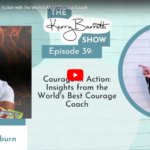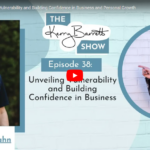
Those of you who know me know that I’m an encouraging, positive person, who is determined to help you conquer the camera and step into your public speaking persona with confidence. If you’ve been following along on social media or keeping up with my blog, you know that I consistently offer my expertise and proven strategies for HOW to do these things.
Today, I’m flipping the script and telling you my top 10 things NOT to do when public speaking. After all, sometimes knowing what doesn’t work helps us dial into what does.
So, here we go…
Don’t fail to prepare
Let’s give a nod to Ben Franklin who supposedly warned, “By failing to prepare, you are preparing to fail.“ He’s not wrong. One of the biggest mistakes you can make is not adequately preparing for your speech. Sure, some people have a natural way with improvisation — and maybe that’s you, or will be you, eventually. For now, as you get started with public speaking, you’ll benefit from thorough preparation. Know your material inside and out, practice your delivery, and anticipate potential questions or challenges.
Don’t clutter your slides
Be kind to your audience’s eyes. While visual aids can certainly enhance your presentation, cluttered or overcrowded slides can overwhelm your audience and detract from your message. So, keep your slides simple, with minimal text and impactful visuals that reinforce your points rather than distract from them.
Don’t talk too fast
This is a telltale sign that you are NOT comfortable onstage or on camera. It’s understandable that nerves can often cause speakers to rush through their words, but it does make it difficult for the audience to follow along. Speaking too quickly doesn’t serve you or your audience. Practice speaking slowly and clearly, allowing for pauses to emphasize key points and give your audience enough time to digest information. When in doubt, put yourself in the seat of an audience member. Are you able to follow and comprehend what you’re saying? Putting yourself in their shoes is a great way to evaluate your delivery and also shift the focus off YOU and onto your material and message instead.
Don’t be boring.
Okay, this sounds obvious, I know. But, a monotonous delivery can quickly bore your audience and diminish the impact of your speech. Harken back to your most boring high school teacher or college lecturer. Spare your audience that kind of pain by varying your tone, pitch, and pacing to keep them engaged. Emotion and enthusiasm can go a long way to keeping them with you and ensuring your presentation lands properly.
Don’t sound fancy for the sake of it
In other words, make your presentation a no-jargon zone. Don’t assume that your impressive vocabulary will make you sound more knowledgeable. Yes, you want to demonstrate expertise, but bombarding your audience with technical jargon or industry-specific language can alienate those who are less familiar with the subject matter. Aim for clear and concise communication that everyone can understand. Save the vocab for your next game of Scrabble.
Don’t overwhelm with information
Look, I get it! It can be tempting to share every detail of your topic, especially if you’re passionate about it, but overwhelming your audience with information can lead to confusion and disengagement. Focus on the most important points and tailor your content to suit the needs and interests of your audience. Ask yourself, “What three things do I want my audience to come away with?” and use your presentation to reinforce those points.
Don’t distract your audience
You know this, but it can be hard to remember when you’re on stage, especially if you’re at all nervous, but certain behaviors, such as fidgeting, pacing, or playing with your props, can distract from your message and undermine your credibility as a speaker. When you prepare and rehearse your presentation, be sure to also practice good posture, maintain eye contact with your audience, and minimize distracting habits.
Don’t ignore the clock
This is a big one for me. Respect your audience’s time by adhering to any time limits set for your speech. Period.
Don’t diss yourself
Seriously. Self-doubt and negative self-talk can undermine your confidence and impact your performance. Don’t focus on or imagine potential mistakes or shortcomings; instead, remind yourself of your strengths and past successes to boost your confidence and motivation.
Don’t leave your audience out of your presentation
I know what you’re thinking… Wait, what? It’s the audience, how could I possibly leave them out? Again, think back to that boring lecturer. Might they have been more compelling if they engaged your voice, rather than drone on and on in theirs? Engaging with your audience can make your speech more dynamic and memorable. And it’s easier than you might think. Try to encourage participation by asking questions, presenting a poll, or introducing interactive activities. Doing so will go a long way to making public speaking more fun for you and your audience!
The Cautionary Takeaway
As you know, I prefer to celebrate what does work and what you should do with respect to public speaking, but cautionary tales have their value, too. In this case, my hope is that by recognizing what doesn’t work, you’ll hone what does a little faster, and with more confidence. You’ve got this!
Need a little more guidance? Want to work with me and really polish your public speaking skills? I’m game! Let’s go!




